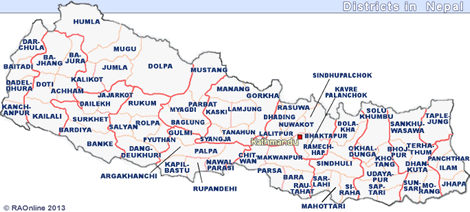|
Nepal's
Civil War - Maoist Insurgency
|
|
 |
War
in Nepal: Facts on Maoists |
|
|
|
| Women
Now Swelling the Ranks of Maoists |
November
3, 2004 (IPS)
Striking
images of young women in fatigues, rifles hoisted on their shoulders and
purposefully marching forward, stare back when one clicks on the official
website of the Communist Party of Nepal (Maoist).
The
Maoists claim that a third of the 'People's Liberation Army' is made up
of women. Within eight years, the Maoist revolution has spread from two
districts in Nepal to almost two-thirds of the country. And women cadres
are visible everywhere, in almost all of the country's 75 districts, as
propaganda activists, agricultural production team members and guerrillas.
Comrade
Parvati (an alias), the head of the women's department of the Central Committee,
states that women have become battalion vice commanders and political commissars.
The
daily round of news briefs of the Maoist insurgency, routinely lists women
Maoists raped, abducted, disappeared and killed, largely by the security
forces.
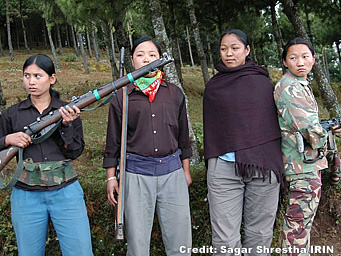 |
| In
the notorious Doramba execution style killing that broke up the 2003 peace
talks, security forces shot dead 19 unarmed members of the district 'peoples
government'. Six of those killed were women.
Days
later, 44-year-old Relimaya Moktan, a female rural health worker in the
village -- suspected of being an informer -- was shot dead by the Maoists
in retaliatory killings.
Evidence
of the growing numbers of women in the Maoist movement, can be gauged by
the rising causalities each time there is a skirmish with the Nepali authorities.
The death toll of women killed in the first two years of the insurgency
was six. |
|
 |
 |
| Young female Maoists seeking refuge in a poor farmer's house. The family
feels uncomfortable about their presence - they fear the reaction of the
security forces if they find out that the family has sheltered rebels. |
| By
2003, according to human rights organisation INSEC, women made up at least
159 of the 1308 killed by the security forces.
The
so-called People's War was launched by the Communist Party of Nepal-Maoist
(CPN-Maoist) in 1996 to abolish the monarchy and install a communist republic.
Clashes between the Maoists and security forces have seen over 10,000 killed.
CPN-Maoists'
chairman 'Comrade Prachanda' admitted that the party was overwhelmed by
the unexpected response of women to join the armed struggle. |
|
The
party propaganda machinery has capitalised on this and frequently eulogises
on the exploits of women guerrillas.
Top
Maoist women leader Hsila Yami has exalted the emancipatory potential of
the movement for women. Before going underground she said: ''The women
have more to gain than men from the People's War. That is why the women,
especially the Tibeto-Burman and non-Aryan women (from the lower castes)
constitute such an important part of the movement.''
Yami
is the wife of the second highest raking Maoist in Nepal, Baburam Bhattarai.
''In
a woman run subsistence agro-economy, where one in every two households
is involved in seasonal migration, women form the majority of the rural
community,'' she said.
''With
de facto female headed households, there can be no agrarian revolution
without mobilising women and putting them in guerrilla fatigues,'' explained
Yami.
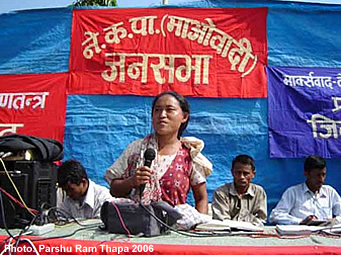 |
| Maoist event in Udayapur |
| Also
Nepal is seeing a mass outflow of particularly young men and boys fleeing
the pincer of the security forces and the Maoists. Estimates of the internally
displaced are more than 200,000. Maoist restrictions on movement in and
out of the villages are dictated not only by security concerns but also
to stem migration overseas.
The
phenomenon of villages 'where there are no men' is now widespread. It is
the women who become the targets of the raids of the Royal Nepal Army and
are also vulnerable to Maoist recruiters.
But
why are girls, who are a high-risk group not leaving their villages? |
|
A
brigadier-general of the Royal Nepal Army informally told IPS: ''The boys
can go across the border and find jobs in India or Malaysia. Where can
the girls go? If they come to Kathmandu or go to India they run the risk
of being trafficked or getting entrapped in the sexually exploitative jobs
here."
Insurgency
apart, some 5000 Nepali girls are trafficked annually to India.
In
Kathmandu through the Maoists Victims Association, this correspondent met
with two girls - 19-year-old Sharmila Gatri and 17-year-old Sangeeta Chettri
(not their real names).
They
said they had left their villages in eastern Nepal to escape forceful recruitment
by the Maoists and were now a working in a Kathmandu bar where sexual exploitation
is common.
According
to Bishnu Sharma of the daily 'Rajdhani' in Lamjung district - where Maoist
recruitments are large -- when the rebels called for one in every family
to join, families were more inclined to send daughters than sons.
Nepali
writer Manjushree Thapa's encounters with Maoist girls in western Nepal
also reinforced this impression.
She
recalls her meeting with 'Comrade Binita' who worked in a team of 'political-motivators'
in Surkhet district.
''This
Maoist woman cadre had three brothers, all of them older than her. She
was the only daughter. And she was the only one to leave her studies and
join the Maoists,'' she told IPS.
''For
many poor, semi-literate girls it seemed the best option available to them
to escape a life of drudgery,'' added Thapa.
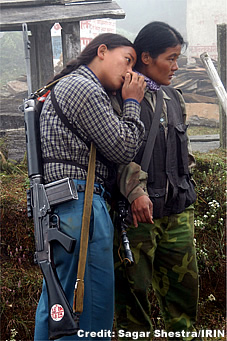 |
| Thapa
quotes a young Maoist girl as telling her this: ''You see, there used to
only be sickles and grass in the hands of girls like us. Now there are
automatic rifles.''
Maoist
women leaders argue that it is the material basis of Nepali women's downtrodden
status in the feudal patriarchal order that has drawn women to the party.
Yami
writing in the daily 'Kantipur' states: ''They are denied parental property
although they run rural households on their own when their husbands are
away earning money.
''When
the men return they marry other women and the wives are forced to leave.
If the women marry someone else, they become outcastes,'' she wrote. ''The
CPN (Maoist) is reversing this feudal practice through its People's War.''
But
behind the rhetoric is Comrade Parvati's own criticism of the party.
''Rarely
are women's issues taken up as a central theme and the party neglects to
implement programmes developed by women's mass fronts,'' she told IPS. |
|
''Women
associated with propaganda work and located much closer to the home seem
to have less opportunities for transcending gender specific roles than
women in the fighting units,'' she added.
Nevertheless,
Comrade Parvati acknowledges the difficulty of women emerging as leaders
in the on-going 'war'.
''The
pressure of marriage and the reproductive cycle obliges them to quit active
participation (in the Maoist movement) after 25 years of age,'' she said.
Maoist
women, she complained, face internal party pressure to get married. ''The
uncertainty of life makes the men insist on early pregnancy.''
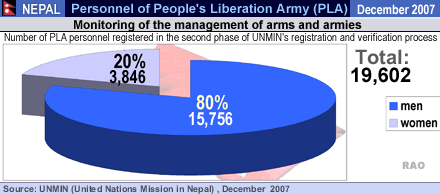 |
|
Statement
by Ian Martin
|
 |
| Ian
Martin: UNMIN was not mandated to supervise the cantonments. UNMIN
was mandated to monitor the management of arms and armies. The PLA commanders
are exercising their responsibility to keep control of the movements of
their personnel, including records as to when people are authorised to
go on leave and return. |
|
|







